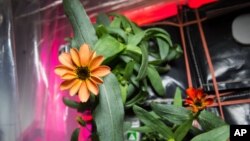Polluted air is a public health problem, not only outdoors, but indoors as well. Experts say it can be even worse inside because of the variety of household chemicals that emit fumes and irritating particulates. Researchers, however, have found that plants, as part of their carbon exchange cycle, can take up these pollutants, clearing the air in homes.
It makes sense in a way since we could not live without plants. They absorb the carbon dioxide that we exhale, and release the oxygen we need to breathe. And we depend on plants to produce an enormous amount of oxygen, according to Vadoud Niri from the State University of New York at Oswego.
“Each of us breathes over 3,000 gallons of air every day. And also, we can’t go without air over three minutes. So it means that air quality is extremely important and we need clean air to breathe every day.”
Scientists say air pollution, caused by chemicals called volatile organic compounds (VOCs), is three to five times greater inside our homes. VOCs include cancer-causing benzene and formaldehyde, which are given off by paints, upholstery, printers and stored fuel.
Indoor air pollution can be the source of “sick building syndrome,” which can cause dizziness, asthma and allergies.
New approach to ‘scrubbing’ air
The traditional way of removing indoor air pollutants is through filtration methods that remove harmful air from the house while pumping in cleaner air from outdoors.
“But we thought maybe we could use an easier and simpler and even cheaper way to get rid of these VOCs,” said Niri. He said the idea to look into plants for filtration came from a 1984 report by the U.S. space agency NASA, which was investigating putting plants on the space station to clean the air.
In a specially designed chamber, Niri and colleagues tested five different plants that are commonly found in central New York homes: the jade plant, spider plant, a bromeliad, Caribbean tree cactus and dracaena. They were exposed to eight different VOCs.
Niri says that each plant absorbed many of the different chemicals, some specific to a particular species.
The bromeliad, for example, took up six of the eight volatile organic compounds it was exposed to. Eighty percent of each chemical was absorbed by the bromeliad plant in just 12 hours. The researchers thought it could not absorb the other VOCs, such as chlorine, because its atoms are too big.
All five plants were effective at removing acetone, the smelly compound in nail polish, from the air, taking up around 94 percent of the chemical. For this reason, scientists are anxious to see how well the plants perform in nail salons.
“We would recommend that instead of having one plant, five of one plant, we chose one of each to make sure that we uptake all types of VOCs from our air,” Niri said of greenery's chemical-absorbing properties.
Niri discussed the air cleansing properties of plants at the annual meeting of the American Chemical Society.
He said the next step is to place plants in actual rooms to see how well they perform.






